
Żurrieq is a town in the Southern Region of Malta. It is one of the oldest towns in the country, and has a population of 11,823 inhabitants as of March 2014. Żurrieq is one of the 10 parishes to be documented in 1436 and is dedicated to Saint Catherine. The island of Filfla is administratively a part of the town. The town stretches from Nigret to Ħal Far. In old times the town had a border with Żejtun. The village of Qrendi used to be part of the parish of Żurrieq until 1618 when it was made into its own parish.

St John's Co-Cathedral is a Catholic co-cathedral in Valletta, Malta, dedicated to Saint John the Baptist. It was built by the Order of St. John between 1573 and 1578, having been commissioned by Grand Master Jean de la Cassière as the Conventual Church of Saint John.

The Our Lady of Victory Church, formerly known as the Saint Anthony the Abbot Church, was the first church and building completed in Valletta, Malta. In 1566, following the Great Siege of Malta, Grand Master Jean Parisot de Valette and his Order showed interest to build a church in the name of the Nativity of the Virgin as a form of thanksgiving; the construction was funded by de Valette.

St Augustine Church is one of the churches built during the creation of the new city of Valletta, Malta.
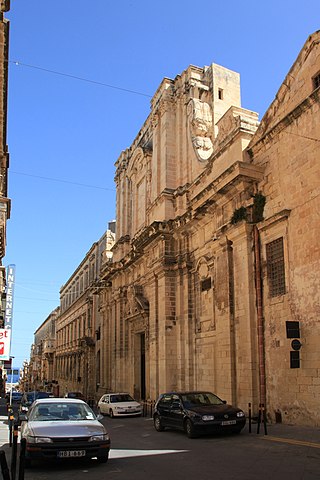
The Church of the Circumcision of Our Lord, also known as the Church of the Jesuits or the Church of the University, is one of the oldest and largest churches in Valletta, Malta. It was originally built between 1593 and 1609 by the Jesuit order, and it is located adjacent to the Old University Building, which originally housed a Jesuit college known as the Collegium Melitense. The church was rebuilt in the Baroque style by Francesco Buonamici after suffering extensive damage in an explosion in 1634. The church remained in use after the Jesuits were expelled from Malta in 1768, and it is also used for Masters and Doctoral graduation ceremonies of the University of Malta, the successor to the Collegium.
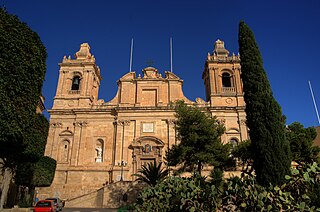
The Collegiate church of Saint Lawrence is an old Church situated in Birgu in Malta.

The Church of St James is a Roman Catholic church in Valletta, Malta. A previous Mannerist church was built on site in the early 17th century and demolished in the early 18th century to build the present baroque church. Built on the designs of Romano Carrapecchia, the church served for religious service to the Langue of Castille. It remain an active church, found in Merchants Street, and it is a scheduled cultural building in a World Heritage Site. The church has a number of artistic features, including its imposing façade and paintings, one drawn by Filippo Paladini and another dating back than the present church itself. Nowadays the church is also used for services by the Ethiopian Orthodox Tewahedo Church and the Eritrean Orthodox Tewahedo Church.
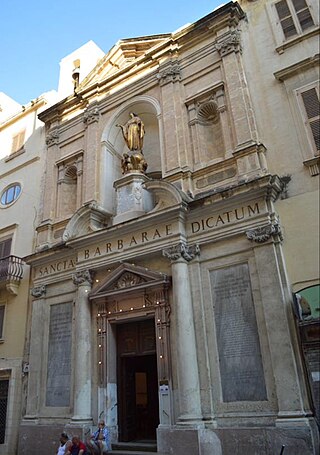
The Church of St Barbara is a Roman Catholic church situated in Valletta, Malta. The church was built to service the spiritual needs of the knights of Provence.

The Church of St Catherine is a Roman Catholic parish church that serves the village of Żurrieq.

The Chapel of St Mary is a medieval chapel located in Bir Miftuħ, limits of Gudja, Malta.
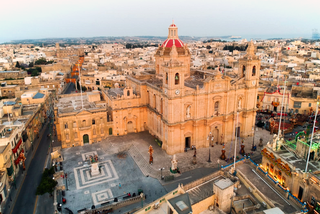
The Church of St Catherine, Żejtun, is a Roman Catholic church, the seat of the archpriest of Żejtun and the mother church of various parishes established from the originally larger territory of the Żejtun parish. The parish church, its oratory and an adjacent pastoral centre form a complex of Grade 1 and 2 listed buildings in the centre of town. The Church and its complex sit in front of the Il-Gwiedi quarter, commanding views from both the Tal-Barrani and Triq l-Aħħar Ħbit mit-Torok town approaches.

The Church of Our Lady of Liesse is a church in Valletta, Malta. The church was built in 1740 on the site of a 17th-century church. The cupola was built to the design of the Maltese architect Francesco Zammit. The church is located on the waterfront of the Grand Harbour, close to Lascaris Battery and the site of the fish market. It is especially venerated by the people of the port area.

Saint George on Horseback is an oil painting by Mattia Preti painted in 1658. It is the altarpiece of the Chapel of the Langue of Aragon in St. John's Co-Cathedral, Valletta, Malta. The painting was Preti's first work in Malta, and it is regarded as one of his masterpieces and one of the best examples of Neapolitan Baroque art.

The Parish Church of Saint Mary, commonly known as il-Knisja l-Qadima is a Roman Catholic parish church in Birkirkara, Malta, dedicated to the Assumption of Mary. It was built in the 17th century, and it has a Renaissance design attributed to the architects Vittorio Cassar and Tommaso Dingli.

St. Catherine's Old Church, also known as St. Gregory's Church, is a Roman Catholic church in Żejtun. The church and its complex sit towards the outskirts of the town, commanding views over Marsascala Bay, St. Thomas' Bay and Marsaxlokk harbour. The church is colloquially known as Saint Gregory's due to a traditional procession held on the first Wednesday following Easter Sunday. Its dedication to Catherine of Alexandria dates back to an original chapel on this site, which was one of the eight mother churches on Malta. The church stands next to the three cemeteries of Żejtun, dedicated to St. Rocco, St. Gregory and St. Catherine. The church's functions as the parish church of Żejtun were taken over by a new parish church, also dedicated to St. Catherine, and designed by Lorenzo Gafà.

St Catherine's Chapel officially the Church of St Catherine and St Peter is an 18th-century Roman Catholic church located in Mqabba, Malta.
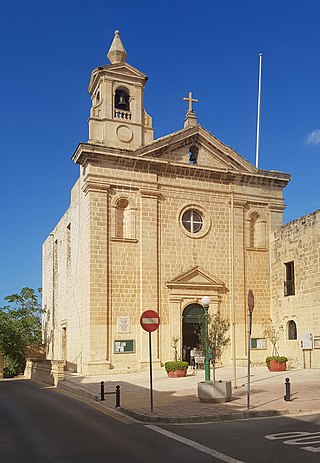
The Old Church of Santa Venera is a Roman Catholic church in Santa Venera, Malta, dedicated to saint of the same name. It was built between 1658 and 1688 on a site of a 15th-century church. It was the town's parish church from 1918 to 1989, when the parish was transferred to the new Santa Venera Parish Church.
Stefano Erardi (1630–1716) was a Maltese painter whose works may be found in many churches around the Maltese Islands. His style has been described as either late Mannerist or Baroque.

The Church of Our Lady of Sorrows is a Roman Catholic church in Pietà, Malta. It was established in the late 16th or early 17th century near a cemetery in which victims of the 1592–1593 Malta plague epidemic were buried. It was originally dedicated to Saint Roch, but after a convent was built next to it in the early 17th century it was rededicated to Our Lady of Sorrows. The church later gave its name to the town of Pietà which developed nearby, and the present building dates back to the mid-18th century when it was reconstructed. Both the church and the convent are currently in the hands of a Catholic youth ministry.

St Catherine's Monastery is a monastery in Valletta, Malta which houses cloistered nuns of the Second Order of Saint Augustine. It incorporates the Church of the Presentation of Our Lady, which is more commonly known as the Church of St Catherine. The church and monastery were built in the 18th century and they replaced a previous monastery which had been housed in a 16th-century palace.






















